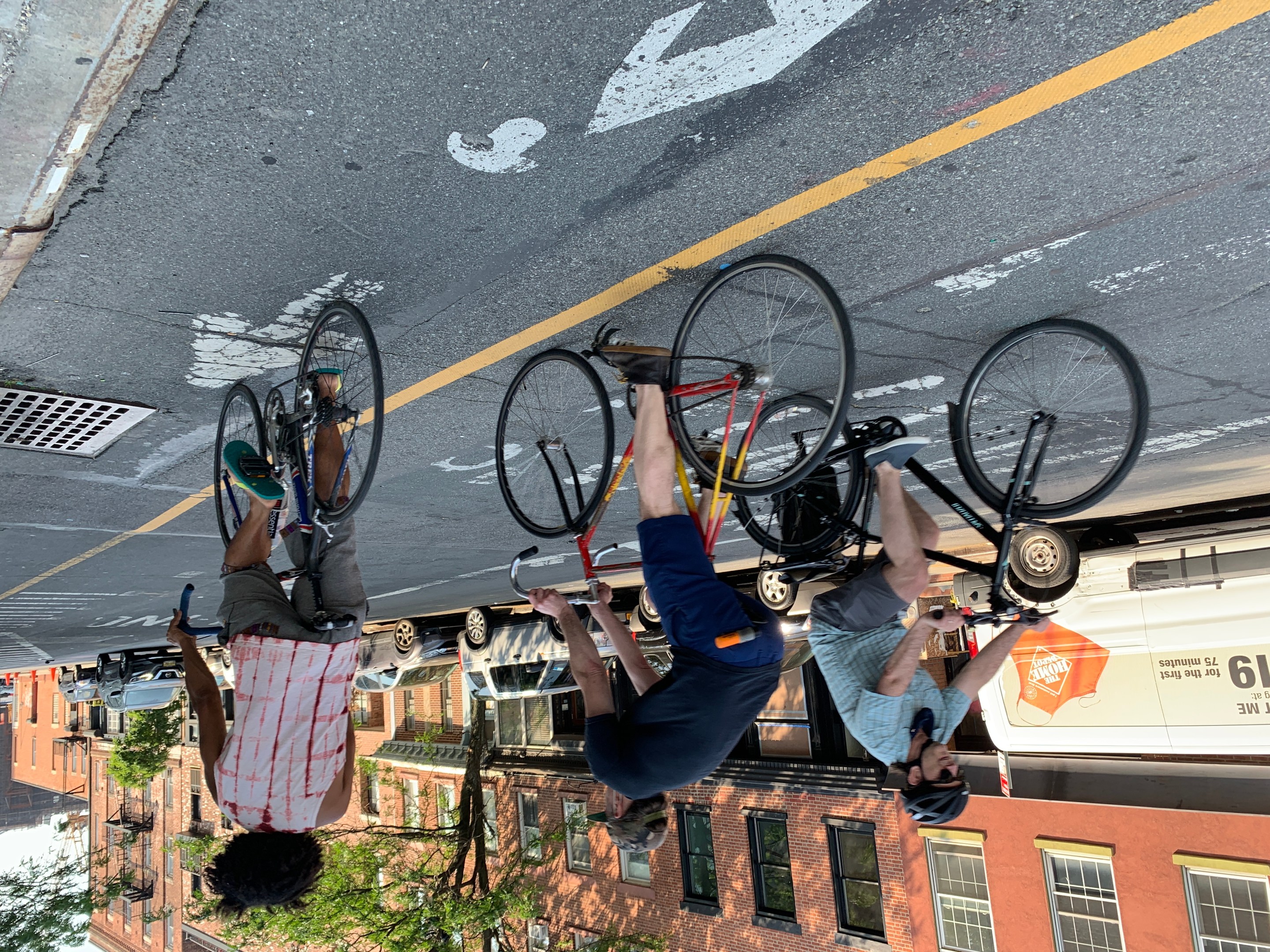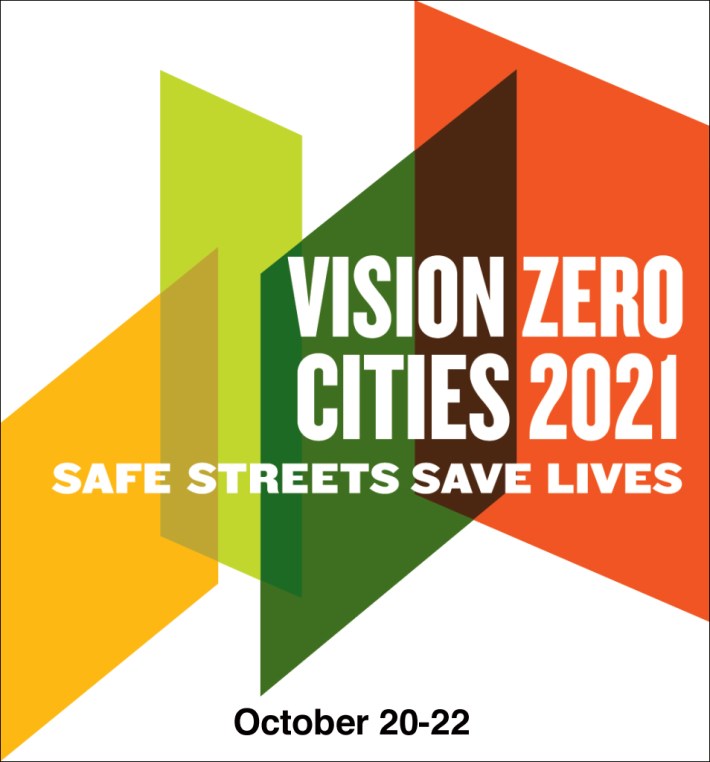Vision Zero Cities Op-Ed: The Myth of the Demon Biker
12:01 AM EDT on October 15, 2021

Cyclists on Kent Avenue in Brooklyn. Photo: Gersh Kuntzman
A version of this article will appear in Transportation Alternatives's Vision Zero Cities Journal as part of the 2021 Vision Zero Cities Conference, Oct. 20-22, including walking and biking tours on Oct. 22. You can still register for the conference and tours at visionzerocities.org.
The New York City media is filled with alarmist stories about pedestrians being hit or nearly hit by cyclists. As a former New York City Transportation commissioner, Janette Sadik-Khan, aptly put it, “A pedestrian killed by a cyclist is guaranteed front-page news status for days on end, while a pedestrian killed by a car rarely registers.”
It’s certainly true that many cyclists run afoul of the law. My students have studied law-breaking cyclists who run red lights, ride the wrong way, ride on sidewalks, or use electronic devices that distract them. Their numbers are not insignificant.
Yet despite all this media attention, little systematic study has looked at the actual incidence of pedestrian injuries caused by collisions with cyclists. How serious a problem is it? Has the rate of pedestrians injured by collisions with cyclists gone up as cycling has grown more popular in recent years? Which is the most vulnerable group of pedestrians injured in such collisions? These are the questions I sought answers to by examining emergency-room hospital records of pedestrians injured in collisions with cyclists.
Pedestrian injuries from collisions with cyclists have dropped
Cycling has been growing in popularity, especially in cities. In New York City, for example, the number of daily cycling trips jumped 134 percent from 2007 to 2017. As a result we might expect that the number of pedestrians who suffered an injury because of a collision with a cyclist also would trend higher. Yet the city, state and national data do not support this expectation. For the country as a whole, the rate of emergency room visits (per 100,000) grew from 2006 to 2007 but then noticeably declined from 2008 to 2016. From 2008 to 2014, the rate dropped from 2.6 to 2.0. The rate dropped even further to 0.85 in 2016 but this could be partly attributed to a change in the International Classification of Diseases coding.
Importantly, the corresponding rates for the state and city also declined sharply in recent years. For New York State the rate fell from 4.27 to 3.36 between 2008 to 2014 (before the change in the coding scheme) and then spiraled downward in the period from 2015 to 2018 from 2.31 to 0.77. For New York City, the rate declined from 7.57 to 7.14 in the years from 2008 to 2014 and then from 6.29 to 5.29 in the time span from 2015 to 2018.
Noteworthy, too, is the change in the incidence of pedestrian injuries related to collisions with cyclists by age group. For pedestrians aged 1-17, the percentage share of the rate of injuries drops markedly from 2005 to 2016. For pedestrians aged 45 and more, the rate veers upward during that time.
Why did cyclist-pedestrian-collision injuries decline?
There are several explanations why, despite the surge in bike ridership, pedestrian injuries owing to collisions with cyclists have been declining. One explanation centers on the changing lifestyle of children. Historically, children (especially those aged 6 to 14) have been the most likely individuals to suffer an injury by colliding with a cyclist. Yet their injury rate has plummeted in the last decade or so — probably because children today are much less physically active and are leading more sedentary lives than before. Instead of playing outdoors, they are staying indoors — using the Internet, playing video games, spending time on social media. This decrease represents the continuation of a long-term trend. In 1969, almost one-half of children in the age group 5-14 (48 percent) walked or biked to school. By 2009, the comparable figure was 13 percent.
Improvements in the biking infrastructure provide another explanation for the diminishing number of injuries caused by pedestrian-cyclist collisions. These improvements include the installation of both protected and unprotected bike lanes and bikeways in many U.S. cities. New York City now boasts a network of almost 1,200 miles of bike lanes, more than double the figure from 2006. Improvements in infrastructure not only promote safer cycling but also enhance the safety of pedestrians. Research carried out in several major cities has found that protected bike lanes raised the safety of all road users — including pedestrians.
Why the media pays so much attention to pedestrian-cyclist collisions
Despite the substantial decline in the number of pedestrians injured in collisions with cyclists in recent years — and the fact that these are only a small fraction of all on-street collisions — pedestrian-cyclist collisions attract a great deal of media attention. This is especially odd because the number of pedestrians killed or injured by motorized vehicles far outstrips the number injured by cyclists. According to a 2018 article in the New York Times, the number of pedestrians killed or injured by cyclists in New York City was “dwarfed by the 107 pedestrians who were killed in motor vehicle crashes last year [2017] and the more than 10,500 other pedestrians who were injured.”
First, it should be stated that these injuries constitute a legitimate public-safety concern. Even if the number of these injuries pales in comparison to that caused by motor vehicles, it's still significant. In New York City in 2018 (the latest year for which data are available), 443 pedestrians were treated in an ER for an injury stemming from a collision with a cyclist — a number that cannot be dismissed as trivial.
One reason the media showers attention on pedestrian-cyclist collisions may reside in the nature of the interactions between pedestrians and cyclists. Pedestrians, particularly those who share multi-use pathways with cyclists, may have an exaggerated fear of cyclists because they are more “stealthy” than cars or trucks. Because they make little or no noise, cyclists are often undetected by pedestrians before they suddenly appear and alarm pedestrians. From an everyday point of view, then, the pedestrian-cyclist interaction is more intimate (and potentially more frightening) than the pedestrian-motorist interaction.
Another reason may lie in the conflict between cyclists and motorists. Some feel cyclists pose a serious challenge to the dominant position of motorists in the urban landscape. Lanes are being taken away from cars and trucks and being converted into bike lanes; so, too, are hard-to-find parking spaces. This has provoked a bitter response on the part of some drivers, who until recently have viewed themselves as the sole and rightful proprietors of street space. In the battle between cars and bikes, those who champion the position of motorists thus have highlighted the reckless behavior of cyclists as imperiling the safety of pedestrians. The injuries suffered by pedestrians in collisions with cyclists have given motorists a weapon to counteract the growing influence of cyclists.
The good news is that the number of pedestrians injured in collisions with cyclists continues to decline. With hope, the expansion of protected bike lanes and the growing awareness on the part of cyclists of the importance of adhering to traffic rules will cause a further decline.
Peter Tuckel, a sociology professor at Hunter College, CUNY, researches pedestrian safety.
Read More:
Stay in touch
Sign up for our free newsletter
More from Streetsblog New York City
Friday’s Headlines: Canal Street Follies Edition
Manhattan Borough President Mark Levine isn't happy. Plus other news.
Daylight Again: Bronx Community Board Backs Parking Ban at Intersections
The Boogie Down is down with daylighting!
Community Board Wants Protected Bike Lane on Empire Blvd.
Brooklyn Community Board 9 wants city to upgrade Empire Boulevard's frequently blocked bike lane, which serves as a gateway to Prospect Park.
The Brake: Why We Can’t End Violence on Transit With More Police
Are more cops the answer to violence against transit workers, or is it only driving societal tensions that make attacks more frequent?






